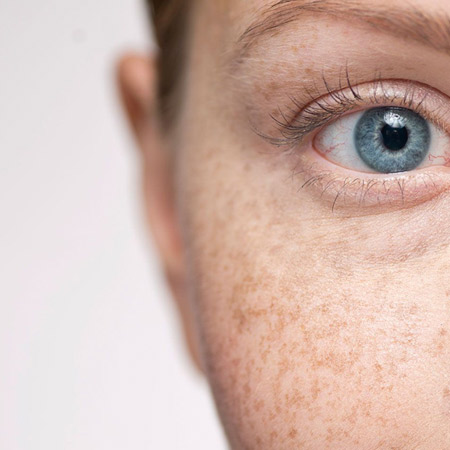Best Pigmentation Treatment In Hyderabad
COLORING OF SKIN WHICH IS RESPONSIBLE BY MELANIN PRODUCED BY THE CELLS IN THE SKIN!!
Skin hyperpigmentation is the most frequent and striking symptom manifesting in a multitude of forms. It represents one of the major dermatological concerns. Hyperpigmentation refers to a dermatological condition that alters the color of the skin, making it discolored or darkened.
Excessive exposure to ultraviolet radiation is known to trigger or exacerbate pigmentation disorders. The most common among them include lentigines, freckles, post inflammatory hyperpigmentation, dark circles, and melasma. Other causes include vitamin deficiency, thyroid dysfunction, few medications, metabolic disorders, infections etc. Allergic reactions to cosmetics and/or fragrance-based products also contribute to hyperpigmentation.

Forms of Hyperpigmentation
Melasma: Melasma refers to an acquired skin condition in which there are irregular patches of light or dark brown or gray-brown pigmentation which appear on the face and the neck regions and predominantly observed in women.
PIH (Post-Inflammatory Hyperpigmentation): Post-inflammatory hyperpigmentation (PIH) refers to dark patches that develop succeeding injury or inflammation of skin like post acne, infections etc.
Solar lentigines: Solar lentigo is a condition in which dark spots develop, commonly referred to as “Age spots” or “Sunspots” can occur anywhere including the face, lips, and body.
Freckles: Freckles is darkened, light brown spots that develop on the facial,neck, and arm areas. They develop during the childhood phase and are more common in lighter or fairer skin individuals.
Pigmentation Treatment
Here are some of the Best Pigmentation Treatment options:
Topical Medications: Topical treatment options include retinoids, azelaic acid, hydroquinone, kojic acid, glycolic acid, tranexamic acid etc. these work by inhibiting the production of melanin by multiple pathways.
Chemical peels: Chemical Peels are a prevalent option for several hyperpigmentation disorders, second to topical ones.
Lasers: Lasers like Q- switched Nd:YAG helps lighten pigmentation and requires multiple sessions. Intense pulsed light (IPL) has shown promising improvements in the treatment of hyperpigmentation. Other treatments include fractional lasers, Microneedling, etc.
Lesions like nevus, tattoos, freckles, dark pigmented lips, etc. don’t seem to be amenable to medical line of treatment. Thanks to state- of-the-art Q-switched Nd:YAG lasers that help in removal of deeper pigmentations that cannot be treated with chemical peels and cream.
Pigmentation Treatment At FMS Skin and Hair Clinics
At FMS Skin & Hair, equipment like FOTONA starWalker MaQX which delivers high-energy Q-Switched laser with Pico power help you get rid of pigmentation.
StarWalker is capable of delivering up to an unprecedented 10 J of Q-Switched energy in one giant structured MaQX pulse. The unique MaQX high energy capability of StarWalker enables the generation of a higher photo acoustic effect at the treatment area, leading to more effective and faster treatments. Additionally, with high MaQX energies, larger spot size can be used resulting in more homogeneous treatments of even deeper lying skin pigments, and therefore with reduced risk of unwanted side effects.
FAQs
What causes Hyperpigmentation?
Hyperpigmentation is skin concern that happens due to alterations in melanin production secondary to excess sun exposure, acne, aging, allergic reactions, melasma, hormonal changes, few medications and medical conditions etc.
Are pigmentation treatments procedures safe?
Pigmentation treatments are safe when done by a certified dermatologist taking all the precautions.
Does pigmentation treatments suitable for all skin types and tones?
There are various treatment options available for treating hyperpigmentation. Treatments are suggested depending on the cause of hyperpigmentation, skin type, sensitive skin etc
How long do pigmentation treatments take to give better results?
Depending on the cause of pigmentation, patients adherence to treatment, and correct photoprotection, results may take 1-3 months to
show.
Are there any side effects with Pigmentation Treatment?
Minor side effects like dryness, hypopigmentation, redness, etc may be noted which subsides eventually.
Does Pigmentation Treatment results permanent?
Results may vary depending on the cause of hyperpigmentation. For example, melasma is a recurrent condition. Sunspots recur if correct photoprotection is not followed.
What are the post-care treatment precautions to be taken?
Proper photoprotection, avoidance of excess sun exposure, And maintenance treatment like topicals etc has to be followed.
Are there any preventive measures to reduce pigmentation?
Proper photoprotection measures like clothing, wide-brimmed hats when in the hot sun, avoiding sun exposure, using broad-spectrum sunscreen adequately, etc. will help in reducing chances of hyperpigmentation.
